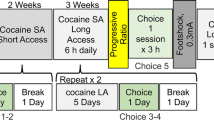Abstract
Rationale
A previous study showed that dopamine (DA) D2 receptors (D2Rs) are involved in the reinforcing effectiveness of food, but the specific involvement of DA D2Rs in choice among food reinforcers remains unclear.
Objectives
The current study used genetic and pharmacological approaches to assess the role of D2Rs in choice among food-reinforcement frequencies using the generalized matching law (GML), which specifies that logged response and time allocation ratios vary linearly with logged reinforcer ratios.
Methods
Congenic D2R knockout (KO) and wild-type (WT) mice were exposed to concurrent variable-interval schedules of reinforcement with scheduled relative-reinforcement rates from 4:1 to 1:4. Effects of the D2R antagonist (−)-eticlopride (0.1–1.0 mg/kg) were assessed in Swiss-Webster mice.
Results
Response and time allocation ratios were related to obtained reinforcement ratios as predicted by the GML. GML fits accounted for ≥92 % of the variance in allocation ratios and did not differ in D2R KO and WT mice. Similarly, there were no significant effects of (−)-eticlopride dose on GML fits, despite effects on overall response rates.
Conclusions
The current results demonstrate that neither deletion nor acute blockade of D2Rs affects choice among response alternatives varying in food-reinforcement frequencies. Because previously published results suggest a role of D2Rs in choice between response alternatives differing in reinforcer magnitude and delay or magnitude and probability, the current findings suggest that D2Rs play a role in choice only among certain parameters of reinforcement. Furthermore, these findings suggest parameters of reinforcement may only be fungible in a complex manner.





Similar content being viewed by others
References
Aparicio CF (2007) Haloperidol, dynamics of choice, and the parameters of the matching law. Behav Processes 75:206–212
Baum WM (1974) On two types of deviation from the matching law: bias and undermatching. J Exp Anal Behav 22:231–242
Baum WM (1979) Matching, undermatching, and overmatching in studies of choice. J Exp Anal Behav 32:269–281
Caine SB, Negus SS, Mello NK, Patel S, Bristow L, Kulagowski J, Vallone D, Saiardi A, Borrelli E (2002) Role of dopamine D2-like receptors in cocaine self-administration: studies with D2 receptor mutant mice and novel D2 receptor antagonists. J Neurosci 22:2977–2988
Chausmer AL, Katz JL (2001) The role of D2-like dopamine receptors in the locomotor stimulant effects of cocaine in mice. Psychopharmacology (Berl) 155:69–77
Chausmer AL, Elmer GI, Rubinstein M, Low MJ, Grandy DK, Katz JL (2002) Cocaine-induced locomotor activity and cocaine discrimination in dopamine D2 receptor mutant mice. Psychopharmacology (Berl) 163:54–61
Elmer GI, Pieper JO, Rubinstein M, Low MJ, Grandy DK, Wise RA (2002) Failure of intravenous morphine to serve as an effective instrumental reinforcer in dopamine D2 receptor knock-out mice. J Neurosci 22:RC224
Herrnstein RJ (1961) Relative and absolute strength of response as a function of frequency of reinforcement. J Exp Anal Behav 4:267–272
Herrnstein RJ, Loveland DH (1974) Hunger and contrast in a multiple schedule. J Exp Anal Behav 21:511–517
Kelly MA, Rubinstein M, Asa SL, Zhang G, Saez C, Bunzow JR, Allen RG, Hnasko R, Ben-Jonathan N, Grandy DK, Low MJ (1997) Pituitary lactotroph hyperplasia and chronic hyperprolactinemia in dopamine D2 receptor-deficient mice. Neuron 19:103–113
Kelly MA, Rubinstein M, Phillips TJ, Lessov CN, Burkhart-Kasch S, Zhang G, Bunzow JR, Fang Y, Gerhardt GA, Grandy DK, Low MJ (1998) Locomotor activity in D2 dopamine receptor-deficient mice is determined by gene dosage, genetic background, and developmental adaptations. J Neurosci 18:3470–3479
Koffarnus MN, Newman AH, Grundt P, Rice KC, Woods JH (2011) Effects of selective dopaminergic compounds on a delay-discounting task. Behav Pharmacol 22:300–311
Locey ML, Dallery J (2009) Isolating behavioral mechanisms of intertemporal choice: nicotine effects on delay discounting and amount sensitivity. J Exp Anal Behav 91:213–223
Martelle JL, Nader MA (2008) A review of the discovery, pharmacological characterization, and behavioral effects of the dopamine D2-like receptor antagonist eticlopride. CNS Neurosci Ther 14:248–262
McDowell JJ (2013) On the theoretical and empirical status of the matching law and matching theory. Psychol Bull 139:1000–1028
McLean AP, Blampied NM (2001) Sensitivity to relative reinforcer rate in concurrent schedules: independence from relative and absolute reinforcer duration. J Exp Anal Behav 75:25–42
Motulsky H, Christopoulos A (2004) Fitting models to biological data using linear and nonlinear regression: a practical guide to curve fitting. Oxford University Press, New York, New York
Risinger FO, Freeman PA, Rubinstein M, Low MJ, Grandy DK (2000) Lack of operant ethanol self-administration in dopamine D2 receptor knockout mice. Psychopharmacology (Berl) 152:343–350
Soto PL, Grandy DK, Hursh SR, Katz JL (2011) Behavioral economics of food reinforcement and the effects of prefeeding, extinction, and eticlopride in dopamine D(2) receptor mutant mice. Psychopharmacology (Berl) 215:775–784
St Onge JR, Floresco SB (2009) Dopaminergic modulation of risk-based decision making. Neuropsychopharmacology 34:681–697
Ward RD, Simpson EH, Richards VL, Deo G, Taylor K, Glendinning JI, Kandel ER, Balsam PD (2012) Dissociation of hedonic reaction to reward and incentive motivation in an animal model of the negative symptoms of schizophrenia. Neuropsychopharmacology 37:1699–1707
Xu J, Vangveravong S, Li S, Fan J, Jones LA, Cui J, Wang R, Tu Z, Chu W, Perlmutter JS, Mach RH (2013) Positron emission tomography imaging of dopamine D2 receptors using a highly selective radiolabeled D2 receptor partial agonist. Neuroimage 71:168–174
Acknowledgments
These studies were conducted with support of the National Institute on Drug Abuse Intramural Program. We also gratefully acknowledge the contributions of Dawn French-Evans in conducting these studies, and W. M. Baum and L. Green for comments on an earlier version of the manuscript.
Conflict of interest
The authors have no conflict of interest to declare.
Author information
Authors and Affiliations
Corresponding author
Rights and permissions
About this article
Cite this article
Soto, P.L., Hiranita, T., Grandy, D.K. et al. Choice for response alternatives differing in reinforcement frequency in dopamine D2 receptor mutant and Swiss-Webster mice. Psychopharmacology 231, 3169–3177 (2014). https://doi.org/10.1007/s00213-014-3495-4
Received:
Accepted:
Published:
Issue Date:
DOI: https://doi.org/10.1007/s00213-014-3495-4




